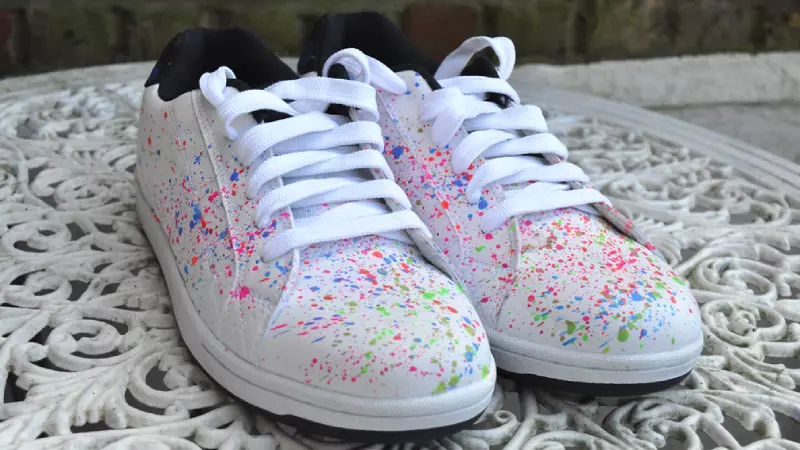How to Get Acrylic Paint Off Leather: For Wet & Dry Paint
Acrylic paint is often used to decorate leather and customize it according to your preferences. You can read more on how to apply acrylic paint on leather in our comprehensive guide.
Moreover, acrylic paint is a non-toxic and water-based paint that performs exceptionally well on leather since it is easy to clean and can be used to hide scuff marks and cracks.
You can breathe new life into your old leather bag or shoes by painting them with acrylic paints since they resist cracking, fading, and rubbing off when applied correctly, compared to other types of paints.
It’s also important to note that acrylic paints are easy to remove with the right tools and techniques since they are water-based. However, this process requires special attention to detail.
Here’s a quick overview of our guide:
This guide will help you learn the correct removal techniques for wet or dry acrylic paints from leather. Ensure that you follow these steps accurately to ensure that you don’t damage your leather article in the process.
Removing Wet Acrylic Paint Off Leather
When acrylic paint is wet, it hasn’t fully bonded with leather yet, making it much easier to remove. Therefore, if you’re looking to remove wet acrylic paint from your leather article, the key is to act fast, before it starts bonding.
1. Wipe Off Wet Acrylic Paint
The most immediate step is to gently blot or scrape off excess acrylic paint from the leather material using a dry cloth or a paper towel. Ensure to contain the area of the spill and not smear and spread the spill onto clean parts of your leather.
Do this gradually and start off by using the tip of the towel or cloth that you’re using. Continue with this until you see that it’s not effective anymore. Then, you can proceed to the next step.
2. Dab Using a Damp Cloth
After blotting away all excess wet acrylic paint from the surface, you should fill up a bowl with warm water and a small amount of mild dish soap. Ensure that the soap is mild and doesn’t contain any harsh chemicals, as that may damage your leather.
Soak a sponge in this solution, wring away the excess liquid, and gently press the damp sponge onto the stain to absorb all of the excess paint still adhering to the surface.
Rinse the sponge after each dab and repeat till the stain is completely lifted from the material. This should remove most of the acrylic paint. However, some parts of the acrylic paint layer may have penetrated the leather. For that, proceed to the next step.
3. Use Wipes for Penetrated Acrylic Paint Stains
If the paint stains on your leather material have penetrated deeper and can not be cleaned properly with a damp sponge, we recommend using special wet wipes for the job.
We highly recommend using MiracleWipes for Leather since they work amazingly with water-based acrylic paints and are compatible with cleaning and nourishing leather products.
You can use the MiracleWipes to clean tough paint stains on your leather article and a microfiber cloth at the end for a flawless and streak-free finish. If you plan to use other types of wipes, ensure that they are leather-friendly.
Important Notice: Please don’t use hygienic wet wipes to remove acrylic paint on leather. Hygienic wet wipes usually contain malic and citric acid, which may damage your leather article.
4. Condition Leather
After you have cleaned your leather article, you can choose to renourish the material with a conditioning product. Although the step is optional, it is best to add a protective and nourishing layer to the leather for a better look and increased durability.
Apply a conditioning product with your fingers or a dry clean cloth to the entire leather surface of your article, and let it dry naturally for a few hours on its own.
The reason why you want to condition your entire leather article is to give it even protection and an even appearance. After the leather has absorbed the vital nutrients from the conditioner, remove the excess layer with a clean cloth.
Removing Dried Acrylic Paint Off Leather
Removing dried acrylic paint is slightly tougher since it has already bonded, seeped into, and tinted the soft leather surface. Once acrylic paints dry, they become resistant to water, making them more difficult to remove.
To remove stubborn dried acrylic paint stains, you need to be gentle and meticulous with the process. You will need clean rags or paper towels, olive oil, cotton swabs, alcohol cleaner, and a conditioning product (optional).
Using only leather wipes may not be effective enough here since our goal is to dislodge the paint from the surface, by breaking its bond, and removing it completely. To understand more about acrylic and leather bonds, make sure to check out our guide on how to seal acrylic paint on leather.
1. Apply Olive Oil
Let’s start with the first step. Take a clean, dry cloth or a paper towel to dab olive oil onto the dried acrylic paint and cover the entire stain with a generous layer.
Next, allow the oil to seep into the surface for a few minutes, which will soften the hardened acrylic paint for easy removal. Avoid overapplication of olive oil, as you don’t want to get that onto your leather.
2. Wipe Off Acrylic Paint
After the paint has soaked the olive oil, try removing small spots with the help of cotton swabs. Although you may not be able to take away large paint stains, you should ensure to use a cloth and not a sharp object.
Take note that sharp objects can damage the leather, when trying to remove the acrylic paint from its surface. We recommend rinsing the cloth and repeating the process until you have removed most of the product from your leather article.
3. Get Rid of Stubborn Acrylic Paint Stains
For tougher stains that persist even after using olive oil, try using rubbing alcohol or a dedicated leather cleaner with a dry cloth. Rubbing alcohol breaks the bonds of the polymer, which binds leather and acrylic paint together, making the removal process much easier.
However, we only recommend this option if you are facing difficulties removing it through an olive oil application. Please be advised to only use this option for stubborn acrylic paint stains.
Rub a damp cloth gently over the paint spot and wipe away the excess acrylic paint with a dry cloth. We discourage you from using acetone on your items since acetone can greatly damage the color and fiber structure of leather.
4. Condition Leather
Conditioning your leather products after cleaning is an optional but recommended step as it prolongs the life of the article. After removing dry acrylic paint from the surface, you should condition the leather to add a protective layer on top.
Rub a small amount of conditioning product on your leather article after cleaning and let it rest for a few hours. Remove the excess product for a smooth and glossy finish.
Best Practices When It Comes to Removing Acrylic Paint from Leather
While our guide provides you with a step-by-step process for removing wet and dry acrylic paint on leather, we also want to share some of the best practices that you should consider.
- Don’t Use Harsh Chemicals – Harsh chemicals can affect your leather product’s original texture, color, and quality. Therefore, we recommend using dedicated leather cleaning products, mild soap solution, or olive oil to remove acrylic paints from leather.
- Try to Remove Stains When They’re Wet – It is best to remove acrylic paints from leather when they are still wet since they have not bonded with the leather just yet and have not deeply stained it. You can easily use a simple soap solution to lift the wet paint stains.
- Don’t Use Acetone – Acetone can be extremely harmful to leather and can cause it to become brittle and discolored. It weakens the leather fibers and can even cause the leather to peel away.
- Don’t Use Sharp Objects to Scrape – Sharp objects can leave scuff marks and even cause tears in the leather, making it highly risky to use scraping tools on leather.
- Only Clean Affected Area – When working on leather, you should ensure you only clean the stained area and don’t end up spreading the color or paint to other areas on the leather article. Improper cleaning can cause more staining, which may ruin your leather’s appearance.

About Gerrit
Co-Founder, Researcher & Writer At Leatherskill
I’m a leather enthusiast who spends most of his free time crafting, researching, and writing about the many facets of this versatile material. Thanks for reading!

